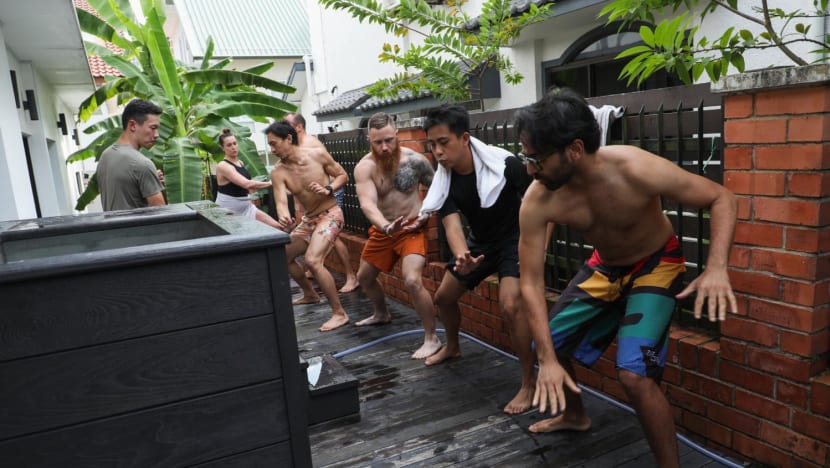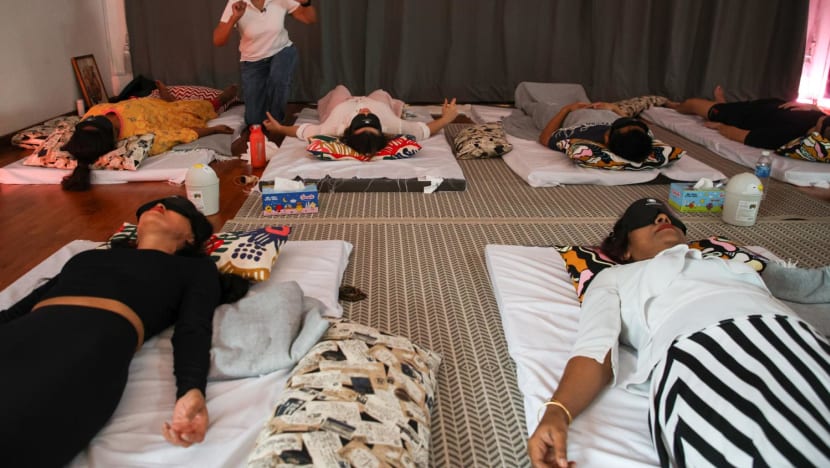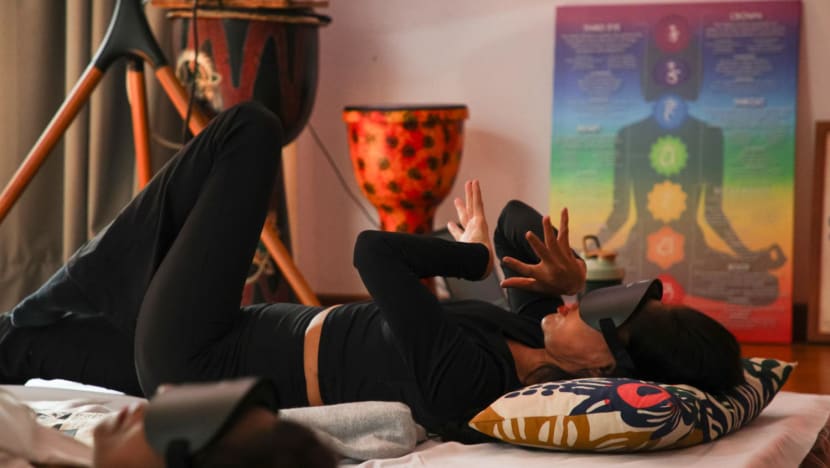Gen Zen: Is how we breathe how we feel? Exploring breathing techniques said to relieve stress, improve well-being
SINGAPORE — Whenever I had expressed any inkling of nervousness or fear throughout my life, the people close to me always echoed the same piece of sound advice: Slow deep breaths. Fill up your lungs with air, hold it there, exhale slowly.
Then do it again, and again, until you feel some semblance of calm and control.
For the most part, even though the anxious jitters that come with uncomfortable situations never disappear completely, such slow, methodological breathing undoubtedly makes me feel better.
Thus the idea that how we breathe affects how we feel always seemed plain and obvious.
Indeed, clinical psychologists to whom I spoke agreed that our breathing patterns have a direct connection to our emotional state and mental well-being.
Dr Joel Yang, a clinical psychologist at the psychological consultancy Mind What Matters, said: “The way we breathe can activate physical changes in the body that can enhance stress, but it can also be one of the fastest ways to feel better emotionally.”
That is why mental health professionals coach their clients to pace their breathing frequency in order to manage their overwhelming anxiety, anger or panic.
Yet after almost three decades of living, I had somehow not given any thought to how else breathing could enrich our lives or help us manage its many tribulations.
So when my colleague asked if I wanted to attend two sessions of “breathwork” — where we consciously control our breathing to influence our mental, emotional or physical state — I saw it as a chance to expand my understanding of this quotidian bodily function that we perform so naturally, yet know so little about.
EXPLORING ‘WIM HOF’ AND HOLOTROPIC BREATHWORK
I was laid out on a yoga mat in a cosy room with ambient music, alongside seven other participants and a trained breathwork instructor guiding us through what is known as the “Wim Hof method”.
We started with slow deep breaths, inhaling deep into our lungs and our bellies before picking up the pace and eventually exhaling every bit of air out.
After holding my breath for about 40 seconds, my arms and legs were tingling from a lack of oxygen. Yet, I felt a deep, blue sense of calm.
Developed by a Dutchman who coined the breathing technique after his own name, it is said to provide one with more energy, reduce one’s stress levels, and instigate an augmented immune response that swiftly deals with disease-causing organisms.
After the session, my instructor, Mr Tan Chun Yih, said: “Being able to dive into these states within a few minutes gives the body a very enlarged bandwidth of understanding what stress and relaxation feels like.
“And the common result of a round of breathwork is you come up feeling a lot more relaxed because of the rollercoaster of stress that we put ourselves through.”
HOW TO DO ‘WIM HOF METHOD’ BREATHING
On the official "Wim Hof method" breathing website, the proper steps to attempt this breathing method are as follows:
- Close your eyes and clear your mind. Inhale deeply through your nose or mouth, while pushing your belly outward. When your lungs are full, let your breath go through the mouth without force.
- Take 30 such breaths, one right after the other.
- After the final exhalation, hold your breath until you feel the urge to breathe again.
- Draw one giant breath, once again letting your belly expand fully. Hold that breath for 15 seconds, then let go. This completes one round.
- Feel free to repeat the full cycle three to four times. Stay focused on your breathing and try not to let your mind wander.
-
Play around with the number of breaths, the tempo at which you breathe and the number of cycles, until you find a routine that works best for you.




Mr Tan, who has been a Wim Hof method instructor since 2019, said the method is also appealing because its benefits can be obtained in 12 to 15 minutes “within one breathing cycle”.
Indeed, throughout the two-hour-long session, I felt intricately aware of my bodily sensations, and relaxed to the point where sleep seemed to be attainable in a snap.
While Wim Hof’s breathing exercises alone claim to provide a whole host of advantages, they are meant to be done alongside cold exposure — a practice which in itself has gained traction for purportedly increasing one’s alertness and resilience, even helping with depression and anxiety.
And so after our breathwork session was over, my fellow participants and I took turns dipping ourselves into an ice bath, where we practised the same breath holds and breathing rhythms to help us tide through the cold.
“Breathwork is a good primer for stress management and relaxation,” Mr Tan said.
“When we jump into cold water, the same stress comes in, yet the participant already knows how to manage their breath, manage their emotions and go through the next set of benefits that cold water exposure will bring.”
In that very room two weeks later, I tried a different type of breathing exercise — one that required me to hyperventilate for an extended period of time.
The practice is known as holotropic breathing, which purports to bring people into “altered states of consciousness” in order to provide an avenue for people to “heal” by releasing deep-rooted emotions.
All around me, I heard my fellow participants breathe in and out heavily, at times making noises that seemed almost primal.
I tried my best to keep up with the fast-paced breathing patterns throughout the session, but my body would tense up quickly and a stinging ache would emerge in the back of my head each time I did so.
WHAT’S THE SCIENCE BEHIND THIS?
Ms Priscilla Shin, principal psychotherapist at Range Counselling Services, said that the way we breathe can influence the "autonomic nervous system", which controls functions such as heart rate and digestion.
Deep breathing typically activates what is known as the "parasympathetic" nervous system, which helps with relaxation and reduces stress.
On the other hand, rapid or shallow breathing tends to activate the "sympathetic" nervous system, contributing to increased stress or anxiety, Ms Shin added.
This would explain the sense of calm I felt with the deep breaths of the Wim Hof method, and the uncomfortable physical symptoms I experienced with the shallow fast-paced nature of holotropic breathing.
“Ultimately, controlled breathing can be a powerful tool for managing stress, regulating emotions and promoting mental well-being,” Ms Shin said.
OTHER HELPFUL BREATHING TECHNIQUES
It is important to note that experts caution against trying the above breathing practices without first speaking to a healthcare professional and understanding the risks involved.
Both the Wim Hof and holotropic breathing methods currently lack extensive scientific research to back up their purported benefits, Ms Shin said, adding that they are not recommended as a replacement for conventional mental health treatments.
Instead, mental health experts recommend mindful breathing exercises and meditation, which have been demonstrated in scientific research to improve emotion processing.
Ms Liew Shi Min, director and clinical psychologist of Heartscape Psychology, said that this would improve our tolerance of distressing emotions, help us accept uncontrollable, difficult situations, and enhance our daily problem-solving skills.
“In addition, it helps with training our attention to focus on the present moment, which is fundamental to being intentional with how we use our time and energy.”
Here are some other recommended breathing techniques that psychologists recommend we can use on a day-to-day basis:
1. Diaphragmatic Breathing
Also known as "belly breathing" or "deep breathing", this technique involves breathing deeply into the diaphragm rather than shallowly into the chest.
To practise, sit or lie down comfortably, place one hand on your abdomen and the other on your chest. Breathe in slowly through your nose, allowing your belly to rise, then exhale slowly through your mouth, letting your belly fall.
2. The 4-7-8 Breathing
This technique is a simple pattern that can be calming.
Inhale through your nose for a count of four, hold your breath for a count of seven, and then exhale slowly through your mouth for a count of eight. Repeat several times to help induce relaxation and calmness.
3. Box Breathing
This method, also known as "square breathing", is used to create a balanced rhythm. This structured breathing pattern can help reduce stress and anxiety.
Inhale through your nose for a count of four, hold your breath for a count of four, exhale through your mouth for a count of four, and then hold again for a count of four.












